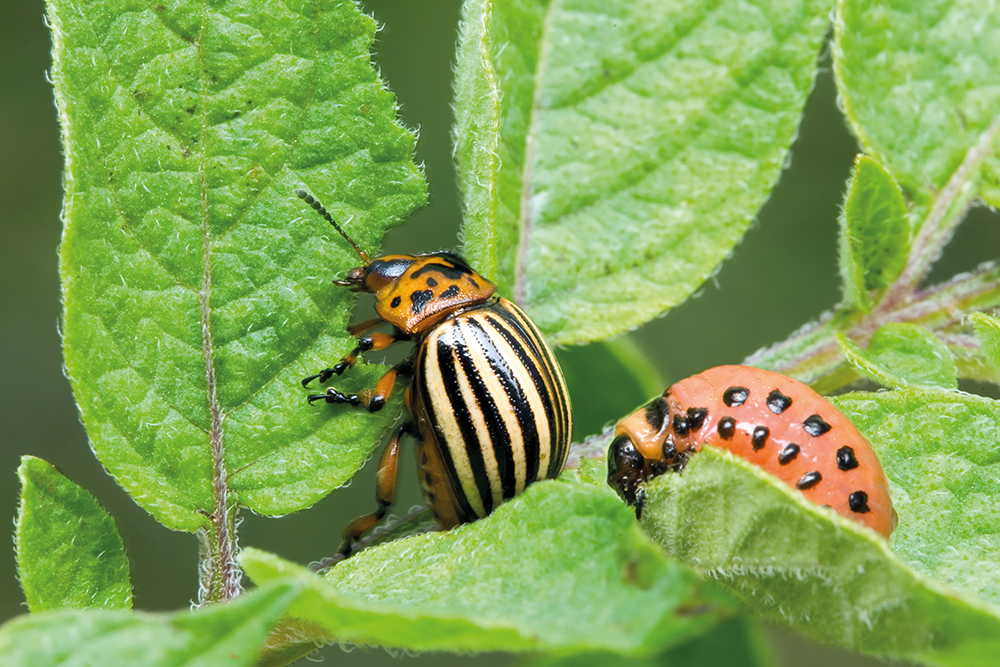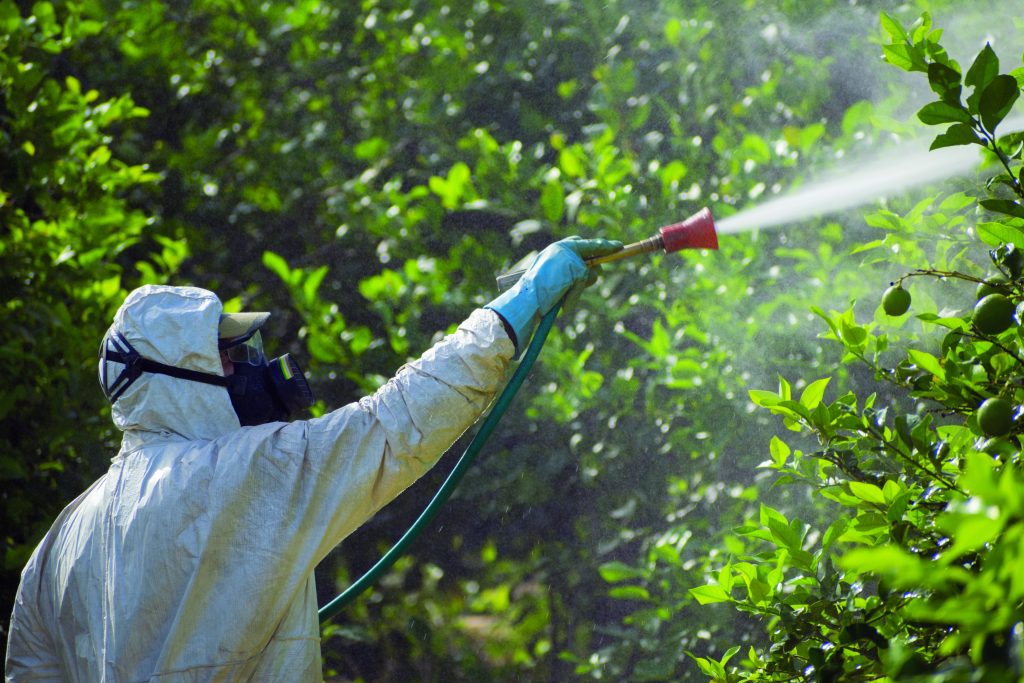Dr David Mota-Sanchez – Knowledge is Power in the Fight Against Pesticide Resistance
First recognised over a century ago, the resistance of insects and other arthropods to pesticides is a growing problem, with implications for crop production and human health on a global scale. Dr David Mota-Sanchez and his team at Michigan State University are creating a worldwide, online database of resistance cases to catalogue the scale of the problem. Their work will aid decision makers in developing sustainable strategies to manage arthropod pests.
Pesticide Resistance
From the production of potatoes and rearing of livestock, to eradicating head lice and reducing cases of malaria – solving the problems created by arthropod pests has everyday applications that most of us have probably never realised.
Arthropods are invertebrates with an external skeleton, segmented body and jointed legs. They are divided into four groups: insects, myriapods (including centipedes and millipedes), arachnids (including spiders and mites) and crustaceans. Arthropods play major roles in maintaining ecosystems, where they act as pollinators, nutrient recyclers, scavengers and food for other animals. However, many are also significant pests that threaten agricultural systems, human health and animal health. This problem has become even greater due to the growing resistance of many arthropod species to the pesticides used to control them.
Resistance, or ‘field-evolved resistance’, is the micro-evolutionary process whereby exposure to a pesticide promotes genetic adaptation, resulting in populations of arthropods that are less vulnerable to that pesticide. Such reduced vulnerability, or ‘practical resistance’, to a given pesticide might result in a loss of pest management tools for current and future generations.
Furthermore, if certain chemical pesticides are overused and misused, they can have detrimental impacts on the environment and human health. Specifically, increased pesticide usage can have a negative impact on non-target species, and consequently, the biodiversity of the wider environment. These non-target species may include pollinators or natural enemies of the targeted pests. In addition, high levels of pesticide residues might end up in food, soil and water.

A Database of Knowledge
Estimates of the impact of pesticide resistance on crop production suggest losses of between $1.4 and $4 billion to the US economy annually. However, the danger that resistance poses goes well beyond this economic impact. In the face of a growing global human population, the crop damage caused due to pesticide resistance has significant implications for food security. Dr David Mota-Sanchez and his team at Michigan State University recognised that without better record keeping and resistance severity assessments, the worldwide impact of pesticide resistance might never be fully understood.
Published cases of pesticide resistance have grown in frequency since the start of the twentieth century, when scientists first began to question whether insects could become resistant to chemical sprays. However, up-to-date records were not readily available or accessible to a global audience. With this in mind, Dr Mota-Sanchez and his predecessors began to develop a database that could offer information from anywhere in the world, while nearly instantaneously updating and reporting the world’s arthropod resistance status. They started by carrying out a comprehensive review of all of the reported cases of resistance over the last 100 years. They then developed criteria to categorise resistance levels, and compiled the results of their review into a new online system, to which new records could be quickly and easily added. As a result of their efforts, the Arthropod Pesticide Resistance Database was born.
‘The Arthropod Pesticide Resistance Database is perhaps one of the most complete databases tracking pesticide resistance cases from all over the world since 1914,’ says Dr Mota-Sanchez. ‘It shows us that up until now, arthropods have developed resistance to more than 349 compounds, and there are now more than 17,000 cases of resistance amongst 612 species globally.’
Importantly, the database will go beyond simply providing a platform for reporting of resistance incidence. It will also deliver a mechanism by which experts can share resistance management strategies, tactics and tools to promote better agricultural production, human and health, international cooperation and scientific progress.
Dr Mota-Sanchez and his team urge researchers to publish their resistance monitoring data in conjunction with data on management practices. This will accelerate progress in determining the most useful actions in response to specific data on the magnitude, distribution and impact of resistance.
‘The Arthropod Pesticide Resistance Database is perhaps one of the most complete databases tracking pesticide resistance cases from all over the world since 1914. It shows us that up until now, arthropods have developed resistance to more than 349 compounds, and there are now more than 17,000 cases of resistance amongst 612 species globally.’

The Battle Against Fall Armyworm
The team’s research into a moth species called the fall armyworm demonstrates how increased knowledge of the mechanisms behind pesticide resistance can be used to inform the development of new pest management strategies. Fall armyworm is one of the main pests of corn in many areas of the American continents. As with many other examples, a reliance on pesticides to control fall armyworm has led to the development of resistance.
Dr Mota-Sanchez and his graduate students Rebeca Gutierrez-Moreno and Omar Posos determined the resistance levels of the fall armyworm to different types of pesticides in populations from Puerto Rico and Mexico. They found that in particular, the Puerto Rican populations showed a remarkable resistance to pesticides with many different modes of action, whereas populations in Mexico showed varying levels of susceptibility to different compounds – possibly as a result of the heterogeneity of pest management patterns in the country.
In Puerto Rico, the team found that the pest is still resistant to two Bt proteins. Bt crops are those that have been genetically engineered to contain a Bacillus thuringiensis (Bt) gene that encode a Bt protein, which offers the plants protection against the fall armyworm. This finding had significant implications for controlling the fall armyworm in the countries where Bt crops are deployed.
In late 2018, the fall armyworm was discovered in Myanmar for the first time, where it has the potential to create short and long-term impacts on crop production. Dr Mota-Sanchez and a Michigan State University delegation collaborated with the Department of Agriculture in Myanmar, to help reduce the pest’s impact by utilising the lessons learned from their research in Puerto Rico and Mexico.
Fall armyworm populations have now also been discovered in neighbouring countries in the region, including Bangladesh, Thailand, China, Indonesia and Australia, and the sustainable management practices implemented and investigated in Myanmar could help to reduce the impact of the pest in these countries as well. The Arthropod Pesticide Resistance Database provides the mechanism for recording and sharing this information at a global scale, to benefit all parties involved.

Evolution of arthropod pesticide resistance from 1914 to 2020. D Mota-Sanchez, and JC Wise, 2020, The Arthropod Pesticide Resistance Database: www.pesticideresistance.org
An Integrated Approach
Dr Mota-Sanchez also collaborated with colleagues from Mexico to study the impact of the long-term use of Bt cotton in Mexico. Prior to the use of Bt cotton in Mexico, it was common for cotton fields to be sprayed with pesticides up to 18 times in a single season. Even with such an intensive application regime, growers still lost more than 30% of their potential yield, mainly due to pests that were highly resistant to pesticides. Since the introduction of Bt cotton more than 20 years ago, pest management in the country’s cotton industry has changed substantially. Growers use around 50% less pesticide and are no longer worried about the insects that previously damaged their yields.
As a result of their research, the collaborators concluded that the high adoption of Bt cotton in Mexico, as part of an Integrated Pest Management (IPM) program, has preserved the susceptibility of insect pests to the Bt toxin, allowing cotton yields to increase for more than two decades.
Aside from the use of genetically engineered crops, there is a huge range of new and old resistance avoidance strategies, tactics and tools available for today’s crop farmers. However, in many cases, those who make treatment decisions probably only choose a single tactic – usually pesticide applications – to limit the damage caused by pests. Dr Mota-Sanchez warns that the sustained use of a single tactic continues to promote resistance.
‘The adoption of many tactics is similar to a chess game,’ he describes. ‘The movements of all the pieces on the board matter and must be coordinated to win the game. Even a pawn can make small favourable contributions. If a chess player carelessly displays the queen, the most powerful piece in the board, the opponent can defeat the player. In pest management, the situation is analogous, if we overuse and expose a particular tactic, such as insecticides, the result is the loss of these tools. Insects have a long history of overcoming pest management insecticides by developing enzymes to metabolise compounds or mutations at the target sites, rendering them innocuous.’
The IPM and Integrated Resistance Management (IRM) approaches that he advocates can reduce the potential for resistance simply by diversifying the mortality mechanisms triggered in target pest populations. IPM and IRM strategies can include the use of newly developed pesticides with novel modes of biochemical action, together with other techniques such as rotations, introducing natural enemies of the pest, the use pheromones, host plant resistance, and the use of refuge to produce susceptible pest individuals.
The development of more diverse strategies for pest control will become ever more necessary as tighter regulations might reduce the use of some insecticides. Even in the absence of government restrictions on insecticide use, management of arthropod populations by chemical means relies on our ability to discover new mechanisms and develop new chemicals at pace. Indeed, in the resistance arms race, the rate of arthropod evolution might outstrip our ability to replace outmoded chemicals.
To avoid this, and alongside an IPM and IRM approach that allows us to preserve the effectiveness of new technologies, we must also address the mix of ecological, genetic, economic and socio-political factors that will improve the implementation of sustainable pest management practices. The Arthropod Pesticide Resistance Database has a pivotal part to play in providing the information and background necessary to implement such an approach, and will have a key role in the future of pesticide resistance management.
Reference
https://doi.org/10.33548/SCIENTIA567
Meet the researcher

Dr David Mota-Sanchez
Department of Entomology
Michigan State University
East Lansing, MI
USA
Dr David Mota-Sanchez gained his PhD in the Department of Entomology at Michigan State University. Here, he is currently an Assistant Professor of Entomology, where his research focuses on the evolution of arthropod resistance to xenobiotics, insecticide toxicology and resistance of arthropods to xenobiotic compounds. The major insect pests he has worked with include Colorado potato beetle, fall armyworm, western flower thrips, codling moth and oblique banded leaf roller. He has also worked on the impact of insecticides on the environment and the movement of pesticides in plant tissues. He is co-Director of the Arthropod Pesticide Resistance Database, which tracks cases of arthropod resistance globally, dating back to 1914. Dr Mota-Sanchez also served as an Embassy Science Fellow with the US State Department and USDA FSA in Mexico to increase awareness and understanding of genetically engineered crops, and is involved in training farmers in Integrated Pest Management. He is also involved in an extension project to train first and next generation of Latino farmers in Michigan, in addition to a research and extension program focusing on the monarch butterfly in Michigan and Mexico.
CONTACT
E: motasanc@msu.edu
W: www.canr.msu.edu/people/david_mota_sanchez
KEY COLLABORATORS
John Wise, Michigan State University
Barry Pittendrigh, Michigan State University
Living with Resistance Project: PS Jørgensen, A Aktipis, Z Brown, Y Carriere, S Downes, R Dunn, G Epstein, GB Frisvold, D Hawthorne, Y Grohn, G Tikaramsa, D Jasovsky, E Klein, G Lhermie, D Mota-Sanchez, C Omoto, M Schlüter, MH Scott, D Wernli, SP Carroll
FUNDING
The Insecticide Resistance Action Committee (IRAC)
Generating Research and Extension to meet Economic and Environmental Needs (GREEEN) Project (Ag Bioresearch Michigan State University)
FURTHER READING
R Gutiérrez-Moreno, D Mota-Sanchez, CA Blanco, ME Whalon, H Terán-Santofimio, JC Rodriguez-Maciel, C DiFonzo, Field-evolved resistance of the fall armyworm (Lepidoptera: Noctuidae) to synthetic insecticides in Puerto Rico and Mexico, Journal of Economic Entomology, 2019, 112, 792–802.
U Nava-Camberos, AP Terán-Vargas, S Aguilar-Medel, JL Martínez-Carrillo, VÁ Rodríguez, MG Rocha-Munive, S Castañeda-Contreras, E Niaves-Nava, D Mota-Sánchez, CA Blanco, Agronomic and environmental Impacts of Bt cotton in Mexico, Journal of Integrated Pest Management, 2019, 10, 15. DOI: 10.1093/jipm/pmz013.
PS Jørgensen, A Aktipis, Z Brown, Y Carriere, S Downes, R Dunn, G Epstein, GB Frisvold, D Hawthorne, Y Grohn, G Tikaramsa, D Jasovsky, E Klein, G Lhermie, D Mota-Sanchez, C Omoto, M Schlüter, MH Scott, D Wernli, SP Carroll, Antibiotic and pesticide susceptibility and the Anthropocene operating space. Nature Sustainability, 2018, 1, 632–641.
BE Tabashnik, D Mota-Sanchez, ME Whalon, RM Hollingworth, Y Carriere, Defining Terms for Proactive Management of Resistance to Bt Crops and Pesticides, Journal of Economic Entomology, 2014, 107, 496.

Want to republish our articles?
We encourage all formats of sharing and republishing of our articles. Whether you want to host on your website, publication or blog, we welcome this. Find out more
Creative Commons Licence
(CC BY 4.0)
This work is licensed under a Creative Commons Attribution 4.0 International License. 
What does this mean?
Share: You can copy and redistribute the material in any medium or format
Adapt: You can change, and build upon the material for any purpose, even commercially.
Credit: You must give appropriate credit, provide a link to the license, and indicate if changes were made.
More articles you may like
Dr Lifei Wang | Can Species Distribution Models Inform Us About Future Ecosystems?
The world is buzzing with news about how human activities and climate shifts are reshaping our ecosystems. Have you ever wondered how life will adapt to this rapidly changing world? Ecologists might be able to predict how different species will live in future using computer simulations. Dr Lifei Wang at the University of Toronto Scarborough investigates how different stimulations work under varying conditions to provide new insights into what may lie ahead.
Dr Yong Teng | Improving the Outlook for Head and Neck Cancer Patients
Dr Yong Teng at the Emory University School of Medicine is working with colleagues to overcome the high mortality of individuals diagnosed with cancers affecting the head and neck. One of his approaches is based on understanding the particular mechanisms of the ATAD3A gene, which new insights suggest are closely related to cancers affecting the head and neck.
Dr Tsun-Kong Sham – Dr Jiatang Chen – Dr Zou Finfrock – Dr Zhiqiang Wang | X-Rays Shine Light on Fuel Cell Catalysts
Understanding the electronic behaviour of fuel cell catalysts can be difficult using standard experimental techniques, although this knowledge is critical to their fine-tuning and optimisation. Dr Jiatang Chen at the University of Western Ontario works with colleagues to use the cutting-edge valence-to-core X-ray emission spectroscopy method to determine the precise electronic effects of altering the amounts of platinum and nickel in platinum-nickel catalysts used in fuel cells. Their research demonstrates the potential application of this technique to analysing battery materials, catalysts, and even cancer drug molecules.
Dr Michael Cherney – Professor Daniel Fisher | Unlocking Woolly Mammoth Mysteries: Tusks as Hormone Time Capsules
The impressive tusks found on proboscideans (the order of mammals that includes elephants, woolly mammoths, and mastodons) are like time capsules, preserving detailed records of their bearers’ lives in the form of growth layers and chemical traces. Frozen in time for thousands of years, these layers can unlock secrets about the lives of long-extinct relatives of modern elephants. Dr Michael Cherney and Professor Daniel Fisher from the University of Michigan used innovative techniques to extract and analyse steroid hormones preserved in woolly mammoth tusks. This ground-breaking work opens new avenues for exploring the biology and behaviour of extinct species.




